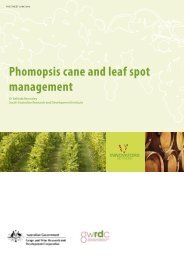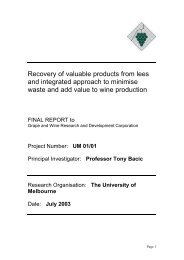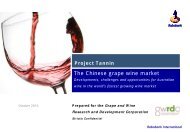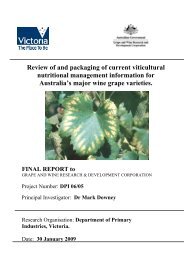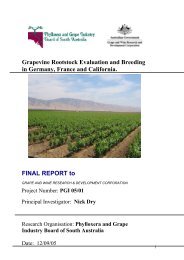Identification of the major drivers of 'phenolic' taste in ... - GWRDC
Identification of the major drivers of 'phenolic' taste in ... - GWRDC
Identification of the major drivers of 'phenolic' taste in ... - GWRDC
Create successful ePaper yourself
Turn your PDF publications into a flip-book with our unique Google optimized e-Paper software.
AWRI: <strong>Identification</strong> Of The Major Drivers Of ‘Phenolic’ Taste In White W<strong>in</strong>es<br />
5.2.4 Statistical Analysis<br />
A three way ANOVA (Factors: phenolics, pH, alcohol) with assessors as a block<strong>in</strong>g variable was<br />
conducted us<strong>in</strong>g MINITAB v14. Means separation was determ<strong>in</strong>ed with Fisher’s Least Significant<br />
Difference.<br />
5.3 Results and Discussion<br />
The addition <strong>of</strong> 30% more phenolics to <strong>the</strong> base w<strong>in</strong>e significantly <strong>in</strong>creased <strong>the</strong> perception <strong>of</strong> astr<strong>in</strong>gency<br />
(p=0.046) (Table 5–1). However <strong>the</strong> strength <strong>of</strong> <strong>the</strong> effect depended on pH. At a low pH <strong>of</strong> 3.0,<br />
astr<strong>in</strong>gency was perceived to be high, and <strong>the</strong> addition <strong>of</strong> phenolics had little fur<strong>the</strong>r effect. However, at a<br />
more realistic pH level <strong>of</strong> 3.3, <strong>the</strong> addition <strong>of</strong> whole phenolics <strong>in</strong>creased astr<strong>in</strong>gency to <strong>the</strong> same level as<br />
<strong>the</strong> low pH condition (Figure 5–1A). This suggests that for this particular w<strong>in</strong>e, <strong>the</strong> 0.3 unit difference <strong>in</strong><br />
pH had <strong>the</strong> same effect on astr<strong>in</strong>gency perception as did an additional 30% phenolics (or vice versa). An<br />
estimate <strong>of</strong> <strong>the</strong> impact <strong>of</strong> phenolic content on astr<strong>in</strong>gency can be made <strong>in</strong> a real-world w<strong>in</strong>emak<strong>in</strong>g<br />
context follow<strong>in</strong>g <strong>the</strong> w<strong>in</strong>emak<strong>in</strong>g trials conducted <strong>in</strong> 2010 (Chapter 8). White w<strong>in</strong>es were made from<br />
three varieties us<strong>in</strong>g both conventional and non-conventional w<strong>in</strong>emak<strong>in</strong>g processes designed to<br />
maximise <strong>the</strong> differences <strong>in</strong> total phenolic concentration <strong>in</strong> <strong>the</strong> f<strong>in</strong>ished w<strong>in</strong>es. Of <strong>the</strong> w<strong>in</strong>emak<strong>in</strong>g<br />
treatments selected, a 30% <strong>in</strong>crease <strong>in</strong> phenolics over those <strong>in</strong> free run controls (as used <strong>in</strong> this model<br />
study) was achieved <strong>in</strong> w<strong>in</strong>es that were made from heavy press<strong>in</strong>gs (measured by total HPLC peak area at<br />
280 nm (Figure 8–10)). While more work is required to quantify <strong>the</strong> relative importance <strong>of</strong> pH with total<br />
phenolic content, it would appear that pH as a factor <strong>in</strong> white w<strong>in</strong>e astr<strong>in</strong>gency has been underestimated.<br />
The base w<strong>in</strong>e was a commercial Riesl<strong>in</strong>g so it conta<strong>in</strong>ed phenolics. Therefore, <strong>the</strong> <strong>in</strong>creased astr<strong>in</strong>gency<br />
result<strong>in</strong>g from pH reduction could ei<strong>the</strong>r be <strong>the</strong> result <strong>of</strong> accentuation <strong>of</strong> <strong>the</strong> astr<strong>in</strong>gency elicited by <strong>the</strong><br />
native phenolics, or that elicited by pH itself. Both effects have been extensively reported. The<br />
astr<strong>in</strong>gency <strong>of</strong> gallic acid (Gu<strong>in</strong>ard et al. 1986), catech<strong>in</strong> (Kallithraka et al. 1997), tannic acid (Peleg et al.<br />
1998), flavanol oligomers extracted from grape seed (Fonto<strong>in</strong> et al. 2008), and whole grape seed tann<strong>in</strong><br />
(Fia et al. 2008) all <strong>in</strong>creased with decreas<strong>in</strong>g pH. Both organic and <strong>in</strong>organic acids have also been shown<br />
to be astr<strong>in</strong>gent like <strong>in</strong> <strong>the</strong> absence <strong>of</strong> phenolics (Hartwig and McDaniel 1995). The maximum level <strong>of</strong><br />
astr<strong>in</strong>gency produced by three organic acids decl<strong>in</strong>ed as pH <strong>in</strong>creased (Lawless et al. 1996) and was also<br />
shown to be a function <strong>of</strong> pH ra<strong>the</strong>r than <strong>the</strong> acid concentration or anion species present.<br />
While <strong>the</strong> addition <strong>of</strong> alcohol did not have a significant effect on astr<strong>in</strong>gency perception (p=0.524), higher<br />
alcohol tended to <strong>in</strong>crease astr<strong>in</strong>gency particularly at lower pH (Figure 5-1 (A)). This trend is contrary to<br />
o<strong>the</strong>r f<strong>in</strong>d<strong>in</strong>gs whereby <strong>the</strong> astr<strong>in</strong>gency <strong>of</strong> red w<strong>in</strong>e (Gawel et al. 2007) and model w<strong>in</strong>es with added<br />
oligomeric proanthocyanid<strong>in</strong>s (Fonto<strong>in</strong> et al. 2008) decreased with <strong>in</strong>creas<strong>in</strong>g alcohol. Ethanol is thought<br />
to weaken <strong>the</strong> <strong>in</strong>teraction between salivary prote<strong>in</strong> acceptor sites and <strong>the</strong> polyphenol hydroxyl groups by<br />
disrupt<strong>in</strong>g hydrophobic <strong>in</strong>teractions (Pascal et al. 2008). Indeed, fewer monomeric phenolics were<br />
Page | 41




